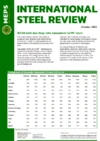September will be key to global pricing fortunes
The steel markets, in Europe and North America, appear to be at a crossroads.
Following the traditional summer holiday months of July and August, it is a widely held view amongst supply chain participants that September will be crucial for global steelmakers, if they are to reverse the negative price trend.
The spike in world steel prices, as a consequence of Russia’s invasion of Ukraine, is now a distant memory.
European and North American steel manufacturers have lost the vast majority of the price gains that they achieved, earlier in the year. This is because initial concerns about shortages of feedstock and finished steel products failed to materialise.
In recent months, high stock levels, import competition and shortening mill delivery lead times encouraged buyers to adopt “wait and see” positions.
Europe
European steel prices continued to drop, this month. However, local steel manufacturers are unlikely to yield further concessions, in the near term – with few new orders expected to be placed in late July and August. They are also reluctant to inform customers of their September and October price intentions.
Many leading steelmakers are planning, either publicly or privately, to undertake extended maintenance stoppages during the summer period. This will tighten supply and, in turn, support the mills’ pricing ambitions.
Steel producers – who are contending with sky-high energy costs – will be emboldened by the likelihood that buyers will return to the market, in the post-holiday period.
End-user activity is expected to pick up, albeit modestly. Major European carmakers are projecting that they will be operating at or near to full capacity, at the end of the third quarter.
Forecast volumes are likely to be revised downwards, though, given the ongoing lack of semiconductors and other components.
Continued spending by the European Union will boost infrastructure-related projects, in the second half of 2022. This is despite inflationary pressures and the growing threat of recession, in many countries.
North America
The steel price trend is similar, in North America, to that witnessed in Europe. Regional steelmakers have been unsuccessful in their attempts to stem the negative price movement.
Hot rolled coil production capacity is expanding, amid the commissioning of new facilities in the US.
Many MEPS respondents, based in the United States and Canada, report that they expect local mills to take steps to withdraw capacity, or even announce a list hike, in an attempt to halt the downward trajectory of prices.
Recent industry data indicates that US mill capability utilisation is 78.9 percent – slightly below the year-to-date figure of 80.4 percent.
Steel producers, in the United States, can take heart from a few noticeable differences from their European counterparts.
Imported volumes – apart from those from neighbouring Mexico – are having a limited negative influence on domestic prices, across the country.
Moreover, end-user activity levels are arguably stronger than those in Europe. The automotive sector is performing well, despite the supply chain problems. Oil and gas-related demand is healthy.
It is becoming increasingly apparent that September may be the only opportunity for global steel producers to spark a reversal of pricing fortunes, before the end of the year.
Any deterioration in economic conditions, however, may severely reduce the extent of any price recovery.

Source:
International Steel Review
The MEPS International Steel Review is an essential monthly publication, offering professional analysis and insight into carbon steel prices around the world.
Go to productRequest a free publication





